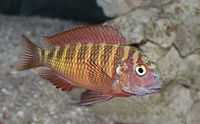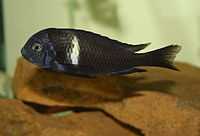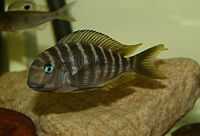Tropheus
| Tropheus | |
|---|---|
 | |
| Tropheus moorii | |
| Scientific classification | |
| Kingdom: | Animalia |
| Phylum: | Chordata |
| Class: | Actinopterygii |
| Order: | Perciformes |
| Family: | Cichlidae |
| Subfamily: | Pseudocrenilabrinae |
| Tribe: | Tropheini |
| Genus: | Tropheus Boulenger, 1898 |
| Type species | |
| Tropheus moorii Boulenger, 1898 | |
Tropheus is a small genus of six species of cichlids endemic to Lake Tanganyika in East Africa. The genus Tropheus is widespread across all regions of lake Tanganyika, from Burundi in the North to Zambia in the South.Males and females are relatively similar but do display obvious sexual dimorphism. Males attain a somewhat larger size. All species maternally mouthbrood their eggs and fry and it is this characteristic that provides their latin name. Tropheus comes from the Greek "trophos" which means "to nurture". The genus is fished lightly by the local population but has never become a staple food fish due to its relatively small size and its habitat which enables it to dart between rocks when threatened.
Most species occur along the coastal fringes of the lake at depths of less than 3 metres. These rocky shores, with numerous rocky outcroppings and boulder formations form a habitat similar to many of the mbuna cichlids of Lake Malawi. This habitat provides shelter and, due to the shallow depth and the long hours of strong sunlight, heavy algal growth on which the Tropheus feed. The only tropheus species to dwell further out and deeper in the lake is Tropheus Duboisi which in general inhabits deeper regions of the lake down to around 15-20 metres. All species are algal grazers and have underslung mouths adapted to rasping algae and microinvertebrates from submerged rocks.
The genus is popular with aquarium hobbyists due to the beautiful markings and interesting behaviour of the fish. Tropheus Moorii in particular has become something of a cult fish within the hobby and many keepers have specialised in keeping nothing else.
Species

There are currently six recognized species in this genus:[1]
- Tropheus annectens Boulenger, 1900
- Tropheus brichardi Nelissen & Thys van den Audenaerde, 1975
- Tropheus duboisi Marlier, 1959
- Tropheus kasabae Nelissen, 1977
- Tropheus moorii Boulenger, 1898 (Blunthead cichlid)
- Tropheus polli G. S. Axelrod, 1977
In the Aquarium

Tropheus species have been popular in the aquarium trade for nearly a century. The fish have, however gained something of a reputation for fragility and are regarded by many cichlid keeping aquarists to be rather demanding to keep. It is certainly true that they should not be considered beginner fish but neither should they be unfairly derided as difficult. When kept in appropriate conditions, they make superb aquarium fish.
Aquarium Set-Up
Tropheus are best kept in species tanks. They are definitely not suitable community tank fish because their unique requirements will not be met in a mixed set-up and because of their innate aggression. Some individuals are more aggressive than others and this is influenced by factors related to the aquarium such as volume and mix of individuals. For these reasons a 300 litre aquarium should be considered the minimum volume and the rule here is definitely "the bigger the better". They should be kept in a group of at least 15 individuals in order to allow aggression to be diffused between the group and not aimed purely at smaller or weaker individuals. A large shoal of these fish is a stunning sight and the fish will display deeper and richer colours and markings when kept in a group.
The aquarium should be set up with piles of flat rocks (slate is a good choice) built up to form crevices and caves for the fish to withdraw into and to help split the tank up and provide territorial boundaries. Fine gravel is suitable, however coral sand or marble acts as a pH buffer increasing the alkalinity and hardness of the water in the aquarium. As Tropheus occur in the surge zone in the wild, the water in the aquarium should be well oxygenated. The aquarium should be well filtered, and small volumes of water should be changed frequently. The water chemistry and temperature should match their natural habitat in Lake Tanganyika, with temperature being very stable at around 25.5c.
Feeding
Tropheus are algae grazers in the wild will only consume minute quantities of animal food (i.e. micro-organisms taken in with the algae whilst grazing). They have a very long digestive tract, and therefore have trouble dealing with higher protein foods.[2] As a result, many people say that the majority of commercially available fish foods are unsuitable for them as they are derived from fish rather than vegetable matter. There are many myths concerning this topic however, and tropheus must be provided with a reasonable amount of protein. Protein in quality foods is actually derived from fish. There are several superb vegetable flakes that are available in all shops based on spirulina and other vegetable matters. But even these contain just as much protein as a quality pellet food. Remember, just because it is green does not mean it's all vegetable matter. That's just dye. They will also do very well on fresh vegetable matters such as romaine lettuce and spinach. The general consensus on feeding is that it is preferable to feed small amounts throughout the day than to give one big feed, because this better matches the feeding behavior of herbivores.
Diseases
Tropheus are susceptible to many viral, bacterial and stress-related diseases, delicate as long as the above issues with water quality and feeding are addressed. They are however known to be particularly prone to a condition called "bloat" which can be very hard to deal with. Bloat is purported to be caused from a range of organisms which include the flagellate (Cryptobia sp.) and/or numerous bacterial species that cause intestinal problems in the genus. Affected fishes discharge white feces, may sway or have swim-bladder problems and frequently stop eating. As with every aspect of fish keeping, prevention is better than cure.
References
| Wikimedia Commons has media related to Tropheus. |
- ↑ Froese, Rainer, and Daniel Pauly, eds. (2013). Species of Tropheus in FishBase. April 2013 version.
- ↑ C Sturmbauer, W Mark, R Dallinger. (1992).Ecophysiology of Aufwuchs-eating cichlids in Lake Tanganyika: niche separation by trophic specialization. Environmental Biology of Fishes.